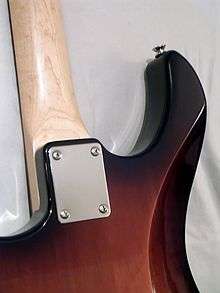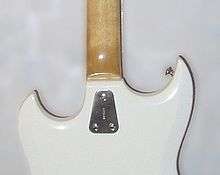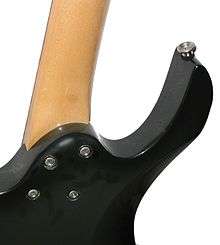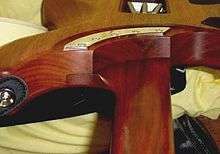Bolt-on neck




Bolt-on neck is a method of guitar (or similar stringed instrument) construction that involves joining a guitar neck and body using screws or bolts, as opposed to glue as with set-in neck joints.
Methods
The "bolt-on" method is used frequently on solid body electric guitars and on acoustic flattop guitars. In the typical electric guitar neck joint, the body and neck cross in horizontal plane, the neck is inserted in a pre-routed "pocket" in the body, and they are joined using four or sometimes three (rarely, five or more) screws.
As the pressure of screw heads damages the wood surfaces, and the undistributed stress could put the instrument body at structural risk, typically a rectangular metal plate (or a pair of smaller plates) is used to secure the joint and re-distribute the screw pressure more evenly. Such a plate is usually criticized for making playing on top frets uncomfortable, so manufacturers sometimes employ some kind of more intricate method to hide a metal plate, smooth the angles and make access to top frets easier. However, a visible metal plate is usually considered as a part of "vintage" style, and provides a ready location to emboss a manufacturer's logos, stamp serial numbers, or include decorative artwork.
Some makers of electric guitars with bolt-on necks (Fender in particular) write a production date on the heel of the component neck, where it is hidden when the neck is attached to the body. The neck can then be removed to check the date, which is often cross-referenced with the serial number to accurately date and identify the guitar.[1]
Bolted joints as opposed to wood screw
The term "bolt-on" is usually a misnomer, introduced mostly by Fender whose electric guitars and basses have largely had component necks held to the instrument's body with wood screws. Actual bolted joints (i.e., a bolt coupled with a nut) exist — particularly in acoustic guitars — but are less common in electric guitars.[2]
An acoustic guitar bolt-on neck popularized by Taylor Guitars includes threaded inserts in the heel of the neck. Bolts inserted through the neck block of the body from inside the instrument attach the neck to the body.[3]
"Bolt-in" as opposed to "bolt-on"
Some sources[4][5] differentiate bolt-on and bolt-in neck construction.
The difference is that a bolt-on neck involves constructing a protruding flange that fits inside a routed pocket in the guitar body. Then the neck is secured inside this pocket using screws that run perpendicular (at right angles) to the surface of the guitar. In contrast, a bolt-in neck doesn't need to have such a flange inside the guitar body, and screws or bolts run parallel to the surface of guitar, entering the back of the heel.[6] This requires the instrument to have a deep, preferably hollow body, meaning its use is restricted to acoustic guitars.
However, given a relative uncommonness of bolt-in necks in electric guitars, most luthiers call both neck joints "bolt-on".
Advantages
Luthiers and guitar players cite both advantages and disadvantages of bolt-on neck construction. Many of these views are highly subjective and relative; instrument manufacture varies widely and, lacking parallel objective factors, any particular claim might not be applicable generally.
Cited advantages of bolt-on neck include:
- easier and cheaper to mass produce.[7] If a guitar of neck-through construction is damaged during the assembly process or otherwise fails its final quality evaluation, the instrument might need to be entirely scrapped; for instance, an irreparable neck flaw requires destruction of an otherwise perfect body, or a finish flaw would require that the entire instrument be refinished. This costs the manufacturer not only materials but the time and manpower involved (at best, salvaging only the hardware). Set-neck instruments (including most acoustic guitars) may be more readily repairable than neck-through, but separating the glue-set joint takes a skilled luthier away from productive duties. The bolt-on style is ideally suited to large-scale assembly lines, defective components are readily separated or replaced by unskilled workers, and recovery costs are minimized.
- easier to repair (if damaged) or to modify. Necks that allow Fender "standard" four-screw joint are widely interchangeable (provided they are intended for the same style of guitar, e.g., either Stratocaster or Telecaster).[8] An aftermarket neck may be readily ordered, selected for the specific preferences of the player (neck shape, fingerboard radius, types of wood, finish, fret profile) and installed by someone relatively unskilled, using only commonly available tools. As well, if a guitar's body is damaged beyond practical repair, the neck is easily paired with another body. Ready removal significantly eases the repair process, whether of neck or body.
- easy to control. The height of a guitar's strings at the bridge is not always ideal, and varies in a mass-production environment. The solution is to change the neck-to-body angle, which is impossible with a neck-through design and difficult with a set-neck. A bolt-on neck can readily have a shim inserted between the heel and body, or even have the heel planed fractionally to change the angle (this method is much superior to shims both structurally and tonally). Some bolt-on designs incorporate an adjustment screw that provides fine adjustment for the neck-to-body angle,[7] such as the Fender "Micro-Tilt" adjustment as used on their Deluxe American Stratocaster.
Disadvantages
Disadvantages of bolt-on construction include:
- upper-fret restriction. Because of the structural necessity of attaching the body to the neck, the result is that the heel area is required to be comparatively thick. In addition, the hardware (particularly a heel plate) adds obstruction. These factors limit how much material can be removed in a cutaway, and then block access to part of whatever room can be achieved. Various designs have been employed to mitigate this, from a contoured heel plate or replacing the plate with a countersunk ferrule under each screw head, up to idiosyncratic neck joint designs such as the Ibanez AANJ (All Access Neck Joint), the Music Man Silhouette, and the Stephen's Extended Cutaway as used by Washburn (particularly the higher-end Nuno Bettencourt signature models).
- sloppy construction or assembly exacerbates any of its inherent disadvantages.[7]
Manufacturers
Notable manufacturers of guitars with bolt-on necks include:
References
- ↑ Fender Serial Number Guide article at the Guitar Repair Bench Luthier Website
- 1 2 Burrluck, Dave (1998). "Types of neck". The player's guide to guitar maintenance: a practical manual to get the most from your electric guitar. London, England: Balafon Books. p. 25. ISBN 978-0-87930-549-9.
- ↑ Bolt-on Neck Joint for Acoustic Instruments article at Liutaio Mottola Lutherie Information Website
- ↑ Bolt-in neck Archived February 28, 2007, at the Wayback Machine. at Sweetwater.com music technology glossary
- ↑ Neck construction Archived December 7, 2006, at the Wayback Machine. article at Ed Roman Guitars
- ↑ William Cumpiano's hardware-based neck joint, featuring drawings that illustrate basics of bolt-in method.
- 1 2 3 4 Lipman, Barry (2002). "What are the pros and cons of bolt-on necks". Guitar questions: the novice's guide to guitar repairs. New York, NY: Cherry Lane Music Co. p. 19. ISBN 978-1-57560-452-7.
- ↑ What we love about Fenders at Guitar DNA